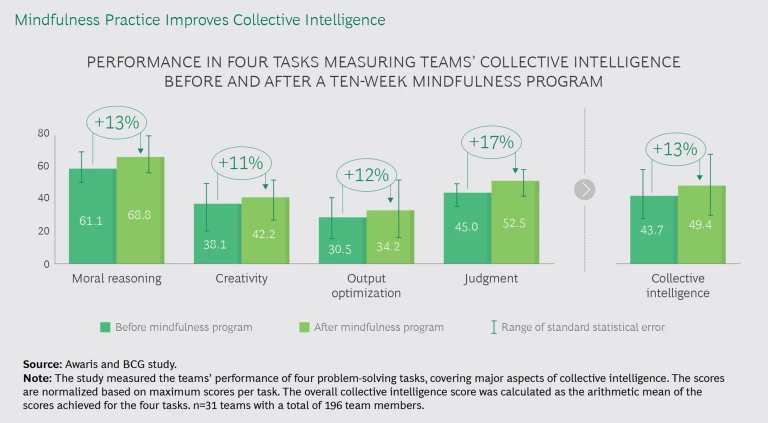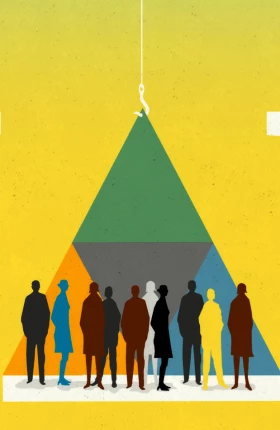How can a company ensure that its collective intelligence is greater than the sum of its parts? Many companies recognize that collective intelligence—the capability of a group of people to solve complex problems—is an important source of competitive advantage. Collective intelligence depends on integrating team members’ diversity, in terms of cognitive styles and world views. All team members must feel emotionally safe to share opinions and ideas and, in turn, be receptive to their colleagues’ viewpoints. But creating a culture of tolerance and acceptance is quite a challenge.
One key to unlocking the potential of collective intelligence is mindfulness—a state of being present in the moment and leaving behind one’s tendency to judge. A study conducted by Awaris (a company that focuses on leadership development and scientifically proven mindfulness-based interventions) and BCG demonstrated that mindfulness fosters collective intelligence: 31 teams that participated in a ten-week mindfulness program showed an average increase of 13% in collective intelligence, as measured by tests developed by the MIT Center for Collective Intelligence . Our study also validated the significant impact of mindfulness on emotional intelligence—people’s awareness of, and ability to manage, their own emotions and those of others—which is essential for increasing collective intelligence.
Leading companies have introduced programs to unleash the power of mindfulness among their employees. But most of these companies have not focused explicitly on the opportunities to use mindfulness to foster collective intelligence. If implemented effectively, even relatively modest investments can generate outsize returns in team performance.
Solving Today’s Complex Problems Requires Collective Intelligence
To manage rapid innovation cycles and the deep interconnectedness of knowledge work, many companies are shifting the paradigm of how people work within their organization’s system. They have invested in new, dynamic ways of working and are setting up cross-functional teams that work iteratively to solve small components of large, complex problems.
But to transition to dynamic ways of working, a company must do more than change processes and structures. It must fundamentally transform how cross-functional teams interact and collaborate. This requires bringing forth an emergent property of their system: the collective intelligence of their teams.
We define collective intelligence as a group’s ability to perform the wide variety of tasks required to solve complex problems. Collective intelligence arises from the cooperation and collaboration of team members working to achieve a shared goal. Their interactions enable teams to rapidly develop solutions that one person probably could never come up with independently, even with an unlimited amount of time.
Collective intelligence is not dependent on team members’ IQ, knowledge, or ability to think logically or on the team’s composition. Instead, it is largely driven by team members’ unconscious processing: their emotional intelligence and emergent properties such as trust, emotional and psychological safety, and equality of participation. This description is supported by studies conducted by the MIT Center for Collective Intelligence and Google’s Project Aristotle . BCG’s experience across a large number of transformations to new ways of working and agile methods also points to emotional and noncognitive factors as the key drivers of collective intelligence.
The concept of collective intelligence in a business organization is not new. But the increasing interconnectedness of knowledge work and the growing variety of problems have raised the profile of collective intelligence as a competitive differentiator. So, companies need to understand the concept more systematically and scientifically.
Tapping into the Power of Diversity
Diversity is among the foundational elements of a team’s collective intelligence. In this context, diversity should not be limited to gender or functional and educational backgrounds. What’s required is a diversity of cognitive styles—that is, different ways of thinking about, perceiving, and remembering information or simply different ways of solving problems or seeing the world. While some people, for example, prefer an adaptive approach to problem solving and tend to orchestrate existing information, others have a tendency to challenge the definition of the problem itself and come up with innovative solutions.
To tap into the power of diversity—with respect to both expertise and world views—a company must create an environment in which individuals are willing to risk stating their opinions and to be receptive to listening to others. This requires integrating a team’s diversity.
Teams whose members are not well integrated exhibit many dysfunctions. Members often lack a sense of joint purpose and struggle to engage in teamwork. The failure to properly integrate a team’s diversity can actually diminish its collective intelligence.
In important respects, a team or organization that fully realizes its collective intelligence by integrating diverse perspectives is analogous to a human brain that consciously adapts to foster new behaviors. (See the sidebar “A Brain Can Learn to Follow New Pathways—and So Can Teams.”)
A BRAIN CAN LEARN TO FOLLOW NEW PATHWAYS—AND SO CAN TEAMS
A BRAIN CAN LEARN TO FOLLOW NEW PATHWAYS—AND SO CAN TEAMS
Mindfulness Provides a Potential Solution
Companies already apply approaches that foster collective intelligence. They are increasingly proficient at setting up diverse teams, breaking down organizational silos, and implementing open information systems. However, companies often do not explicitly recognize how these efforts relate to collective intelligence and thus they fail to capture the full benefits.
Most notably, companies are not doing enough to identify and address inadequate emotional safety and trust among team members. That is because most companies are not sufficiently aware of people’s unconscious interactions and do not understand how unconscious factors influence team performance. Most companies also lack the skills and perseverance to constructively address issues related to emotional safety and trust.
Mindfulness provides a potential solution for meeting these challenges. Many companies have introduced mindfulness into their organizations, primarily to help their employees maintain well-being and improve their clarity of thinking, cognitive abilities, and ability to stay calm. However, only a few organizations (progressive entities including the European Commission, Google, Hilti, and SAP) have also applied mindfulness to transform the collective capabilities of teams. Two examples highlight the opportunities:
- Hilti. Hilti is a global leader in developing, manufacturing, and marketing products for the construction, building maintenance, energy, and manufacturing industries. The company has a long track record of fostering a positive workplace culture through a structured process called “Our Culture Journey.” Based on feedback in the annual employee engagement survey, the company decided to dedicate the next phase of this culture journey to addressing the challenge of how employees can manage their workload and build resilience. It developed a two-day program that focused on creating awareness of the stressors arising in the workplace and in individuals’ private lives. The theme of the program, which the company rolled out to all 30,000 team members worldwide, is the inseparability of performance and care; it emphasizes that collective intelligence and high performance arise naturally when people take care of themselves and each other and foster a culture of collaboration. Mindfulness practice was a core component of this program. Teams reflect on how they can anchor mindfulness and positive habits in their teamwork to support each other.
- The European Commission. Recognizing the heightened challenges in the political environment, the European Commission sought to bolster a core strength of the European project: collaboration. To instill habits of collective problem solving in its organization, the commission embarked on a program to train leaders and employees in mindfulness. The program enhanced the ability of teams to work together in a caring and collaborative way.
Most people who regularly practice mindfulness have an intuitive understanding of its connection to collective intelligence. What’s more, the effect of mindfulness practice on collective intelligence is objectively measurable.
Awaris and BCG conducted extensive research to confirm the hypotheses of this article. We measured the collective intelligence of 31 teams, totaling 196 people, from a large German automotive company and a political organization. We took measurements twice—before and after a ten-week mindfulness program. (See the sidebar “About the Study.”)
About the Study
About the Study
Thirty-one teams, composed primarily of people with managerial responsibilities, participated in a ten-week mindfulness training program that was specifically adapted to the work context. The study focused on investigating whether a team’s collective intelligence can be enhanced by mindfulness training of its members.
To measure collective intelligence, we used a set of four diverse tasks developed for this purpose by the MIT Center for Collective Intelligence:
- Moral Reasoning. Teams received a case study of a problem that presented conflicting interests among several parties. We asked the teams to determine, from an ethical perspective, the most suitable solution for all parties. Responses were scored by the degree to which the groups considered the balance of competing perspectives in the problem.
- Creativity. Teams had to build a complex Lego structure while taking into consideration tight constraints relating to size, quality, and aesthetics. The resulting Lego structure was scored on the accuracy of meeting those constraints.
- Output Optimization. Teams were scored after performing a shopping exercise in which they had to maximize the quantity and quality of goods purchased while minimizing the costs of goods and time spent shopping.
- Judgment. Teams had to estimate and agree upon quantities for 20 diverse questions (for example, “What was the highest recorded temperature in the US?”). Teams were scored based on the accuracy of their estimations.
The selection of the tasks was based on Joseph McGrath’s model of group tasks. This ensured that we covered major aspects of collective intelligence, such as decision making, task execution, generation of innovative ideas, and negotiation.
In the first session of the program, we randomly assigned one, or in some cases two, of the tasks to each team. We scored each team’s performance of its task. During this initial session, we also conducted an individual assessment of each team member’s mindfulness (using the “Five Facet Mindfulness Questionnaire”) and emotional intelligence (using the “Reading the Mind in the Eyes” test).
In the final session of the mindfulness program, we repeated the process. We asked each team to perform one or two of the tasks that it had not previously performed. We then scored its performance on the new task and conducted another assessment of mindfulness and emotional intelligence.
At the conclusion of the study, we used the arithmetic mean of the improvement of teams’ performance scores for the four tasks to determine the increase in collective intelligence. We also correlated the results of the individual assessments of mindfulness and emotional intelligence to determine the extent to which these two attributes are associated and predict collective intelligence.
After the mindfulness program, the teams’ collective intelligence—measured through four diverse problem-solving tasks—increased by an average of 13%. (See the exhibit.) Moreover, we found that mindfulness is significantly associated with emotional intelligence and that individual and group mindfulness scores predicted a team’s collective intelligence.
Mindfulness practice fosters collective intelligence by allowing us to redirect our mental attention skills (for example, capabilities of the working memory or our ability to focus on the task at hand) toward more expansive, awareness-based skills. Cognitive science tells us that attention is usually narrowly focused on the self (that is, “me-based”). In contrast, awareness is more relational, open, and focused on others (that is, “we-based”).
More specifically, mindfulness practice strongly influences a person’s self-awareness of the body’s internal state (interoception) and mental processes (metacognition). Interoception and metacognition help us regulate our reactions to emotions and behaviors. By improving our ability to get in touch with our own emotions, we also enhance empathy—our ability to vicariously share the experiences of others.
By increasing self-awareness and empathy, mindfulness impacts two areas that directly promote collective intelligence:
- Communication and Prosocial Behavior. Team members who embrace mindfulness are better listeners and can react in an emotionally intelligent way when tension or disagreement arises. Their style of interaction encourages other team members to speak up and participate in creative processes and allows them to integrate their diverse cognitive styles.
- Leadership. Mindfulness training helps leaders improve their ability to self-reflect. Mindfulness is also associated with important leadership capacities such as flexibility, authenticity, and humbleness.
Three Steps to Applying Mindfulness
To use mindfulness to foster collective intelligence, a company must take three steps. First, it must train leaders and employees on how to personally establish a mindfulness practice. Second, it must anchor mindfulness habits in teams. As the final step, it must continually measure the impact of mindfulness on collective intelligence and adapt the practices in response to what the measurements reveal.
Provide mindfulness training. Mindfulness practice comprises a set of mental and emotional exercises that affect the functioning of the brain in a measurable way. Several proven methods of mindfulness training can help team members and leaders establish a personal mindfulness practice. For example, companies can apply a ten-week program—as we did for our study—that begins with a workshop that explains the neurophysiological basics of mindfulness and its impact on collective intelligence. The workshop is followed by a practice period supported by a mindfulness app, frequent webinars, coaching, and peer-to-peer learning groups so that individuals learn to make mindfulness practice a daily routine.
Anchor mindfulness in teams. Mindfulness can evolve from a practice to a state and eventually become a trait—when the various underlying skills have become embedded in a person’s mental and emotional makeup. Team interactions provide valuable opportunities to embed these skills. To promote mindfulness, organizations must clearly state that teams should practice three simple types of habits that foster psychological safety and collective intelligence:
- Attention and Focus. Teams need to establish specific habits that promote attentiveness. For example, a team can observe one minute of silence before the start of each meeting. By focusing their breathing during this moment, team members will be better able to direct their attention during the meeting. In addition, how team members deal with devices, listen to each other, and speak can significantly affect the degree of presence and openness in the meeting.
- Care and Positivity. When people feel trust, efficacy, and appreciation, they engage and contribute. But when they do not, they hold back and divert their energy to other things. As a result, demonstrating care and positivity in teamwork—noticing what colleagues have achieved and done well and appreciating their contributions—can be very important to improving the sense of bonding and community.
- Emotional Awareness. Team members should allow emotions to surface so that expressing emotions becomes a natural part of what it means to work together. Processes for surfacing emotions include having check-ins during which team members share how they feel emotionally before a meeting, as well as regular retrospectives in which members share their feelings on the interactions within their team.
Establish metrics and track behavior changes. Just as manufacturers meticulously track physical safety on their shop floors, companies should track emotional or psychological safety in their knowledge environments. As a starting point, companies can use surveys and interviews to ask employees whether they believe the company has clearly articulated that emotional safety and psychological safety are goals and whether they understand how to create such safety.
To start using mindfulness to foster collective intelligence, executives can launch a ten-week mindfulness coaching program with a few teams and measure the impact. The results of this pilot will likely demonstrate that mindfulness has a positive impact on team performance and inspire a company-wide discussion about the value of collective intelligence and psychological safety.
Following a successful pilot, a company can adapt mindfulness training and habits to suit its culture and roll out a program across the organization. To convince the skeptics, it is essential to apply deep expertise in mindfulness training. Those companies that succeed will fully realize their collective intelligence and thereby reap the rewards of new ways of working and cross-functional teaming.












